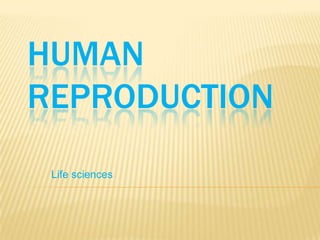
Human reproduction explained
- 2. REPRODUCTION Living things create other living things in the process of reproduction . Human beings reproduce through sexual reproduction.
- 3. PRIMARY SEXUAL CHARACTERISTICS The reproductive system are the primary sexual characteristics . We alredy have them when we are born and there are different for male and female.
- 4. SECONDARY SEXUAL CHARACTERISTICS The external characteristics which differentiate men from women are called secondary sexual characteristics. During puberty, between the ages of eleven and fifteen, the reproductive system matures. Some physical changes are the same for both sexes, like growing taller or hair growing in the armpit. Other charges and specific to each sex: Girls develop breasts and their hips get wider. Boys get deeper voices.
- 6. REPRODUCTIVE CELLS Reproductive cells carry out the function of reproduction. Sperm are the male reproductive cells. They are small. They have a head and a long tail called a fragellum. They are produced in large numbers from the time of puberty. Ova are the female reproductive cells. They do not move. From puberty, an ovum matures every month.
- 7. SPERM CELL
- 8. THE FEMALE REPRODUCTIVE SYSTEM The female rproductive system is made up of these organs : The ovaries produce the ova. The uterus is where the baby develops. The fallopian tubes connect the ovarios to the uterus. The vagina connects the uterus to the outside of the body. The vulva is the external part of the female reproductive cells.
- 9. CROSS SECTION OF A FEMALE
- 10. THE MALE REPRODUCTIVE SYSTEM The male reproductive system is made up of these organs : The testicles are outside the body. They produce sperm. They are covered by a bag of skin called the scrotum. The vas deferens take sperm from the testicles to the urethra. The urethra takes the sperm outside the body. The seminal vesicles and prostate produce seminal fluid and send it to the urethra. The penis is outside the male reproductive system.
- 11. CROSS SECTION OF A MALE
- 12. FERTILISATION Fertilisation occurs when an ovum and a sperm join inside the Fallopian tubes and they create a single cell called a zygote. The zygote goes down the Fallopian tubes, it is implanted in the wall of the uterus and it becomes an embryo.
- 13. PREGNANCY Pregnancy lasts about 9 months and ends in a birth. During the early stages, different structures are created to protect the embryo. The placenta takes nutrients and oxygen from the mother`s blood to the embryo. The umbilical cord connects the embryo to the placenta. The amniotic sac protects the embryo. The baby develops step by step : After 3 months: the embryo has all its organs. It becomes a foetus. After 5 months: the baby`s body develops and it starts moving and the mother feels it. After 9 months: the baby is ready to be born and it weighs around 3 kilos.
- 14. EMBRYO
- 15. LABOUR The process of giving birth is called labour. Labour takes place in three phases: Dilation: rhythmic contractions make the opening of the vagina and vulva big enough for the baby to come out. Expulsion: the baby is born and the doctor cuts the umbilical cord. Afterbirth: the placenta comes out of the mother`s body.
- 17. REPRODUCTION Definition Primary sexual characteristics Secondary sexual characteristics Reproductive cells Next
- 18. DEFINITION Human beings reproduce through sexual reproduction, bringing male and female sex together. Return
- 19. PRIMARY SEXUAL CHARACTERISTICS We already have them when we are born and they are different for male a female. Return
- 20. SECONDARY SEXUAL CHARACTERISTICS This characters are the external characteristics which differentiate men from women an appear during puberty with some physical changes. Return
- 21. REPRODUCTIVE CELLS Carry out the function of reproduction: •Sperm •Ovary Are the male reproductive cells Are the female reproductive cells Return
- 22. THE REPRODUCTIVE SYSTEM The female reproductive system The male reproductive system Fertilisation Next
- 23. THE FEMALE REPRODUCTIVE SYSTEM Is made up of these organs: Fallopian tubes uterus vulva Return ovary vagina
- 24. THE MALE REPRODUCTIVE SYSTEM Is made up of these organs: urethra penis vas deferens Return seminal vesicles prostate scrotum testicle
- 25. FERTILISATION Occurs when an ovum and sperm join and they create a cell called zygote. Return It is implanted in the wall of the uterus and it become an embryo.
- 26. PREGNANCY AND BIRTH Pregnancy, protective structures Pregnancy, baby development Birth, labour Next
- 27. PREGNANCY, PROTECTIVE STRUCTURES During the pregnancy different structures are create to protect the embryo. Placenta: takes nutrients and oxygen. Umbilical cordon: connects the embryo to the placenta. Amniotic sac: protects the embryo. Return
- 28. PREGNANCY, BABY DEVELOPMENT • After 3 months: the embrion has all its organs. It becomes an foetus • After 5 months: the foetus starts moving • After 9 months: is ready to be born Return
- 29. PARTS OF THE LABOUR 1 2 3 Dilation: the contractions make the opening of the vagina and vulva big enough for the baby to come out. Expulsion: the baby is born. Afterbirth: the placenta comes out of the mother’s body. Return 1 2 3
- 30. ALVARO HELENA ALEX MARCOS FIN M.
- 31. REFERENCES This presentation is a mash up from different sources. They are Sacha herrero Giraldo 6-A http://www.slideshare.net/Crelgo/human-reproduction-sacha http://www.slideshare.net/Bonaval81/human-reproduction28781095?qid=041ee5bd-e3fb-4a10-92abdb9e663552f9&v=default&b=&from_search=4
